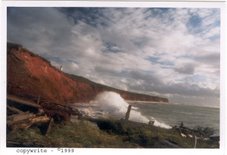The American Lobster (Homarus americanus)
 The American lobster is widely acclaimed for it's delicious meat and is the mainstay of the fishing industry on the Magdalen Islands. Their shell-armoured body is divided into two main sections, the combined head and thorax, and the six-jointed abdomen commonly called the "tail". There are two pairs of antennae, a complicated set of mouth parts, and two black eyes mounted on short movable stalks set on either side of a stout, spiny horn.
The American lobster is widely acclaimed for it's delicious meat and is the mainstay of the fishing industry on the Magdalen Islands. Their shell-armoured body is divided into two main sections, the combined head and thorax, and the six-jointed abdomen commonly called the "tail". There are two pairs of antennae, a complicated set of mouth parts, and two black eyes mounted on short movable stalks set on either side of a stout, spiny horn.The body rests on four pairs of spindly, jointed walking legs, the first two pairs of which have small claws. Two large front legs provide the lobster with formidable tools for capturing food. The are well-armed with strong claws generously equipped with teeth and sharp spines. Usually, on claw is considerably heavier and is known as the "crusher" in contrast to the other, more slender "pincer". There is a series of small paddles or swimmerets on the underside of the abdomen, which ends in a wide, flattened tail fan.
The shell is often speckled with dark spots and varies in colour from greenish blue to reddish brown. Lobster are great scavengers and live chiefly on fish (dead or alive) and immobile or slow moving invertebrates such as mussels, sea urchins, crabs and worms which inhabit the sea bottom. Lobsters in the commercial catch are larger on the islands than elsewhere in North America because of the conservation methods implemented by the Department of Fisheries and Oceans Quebec.
The annual commercial catch for the Magdalen Islands exceeds $50 million.
The shell is often speckled with dark spots and varies in colour from greenish blue to reddish brown. Lobster are great scavengers and live chiefly on fish (dead or alive) and immobile or slow moving invertebrates such as mussels, sea urchins, crabs and worms which inhabit the sea bottom. Lobsters in the commercial catch are larger on the islands than elsewhere in North America because of the conservation methods implemented by the Department of Fisheries and Oceans Quebec.
The annual commercial catch for the Magdalen Islands exceeds $50 million.





No comments:
Post a Comment